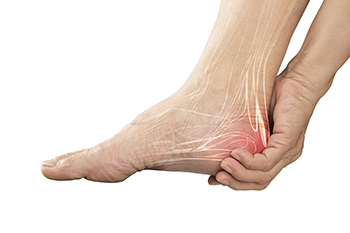

Plantar fasciitis is the most common cause of heel pain. This condition is the inflammation of the tough band of tissue, called the plantar fascia, that runs along the sole of the foot from toes to heel. This tissue helps support the arch and plays an important role in foot mechanics when walking. Causes of plantar fasciitis include standing or walking for long periods, heel spurs, pregnancy, and obesity. Wearing shoes with little or no cushioning in the heel and sole, as well as walking barefoot, may also contribute to the inflammation. The pain of plantar fasciitis is usually a stabbing sensation, felt most in the heel. It tends to be worse upon awakening or after prolonged activity. When pressure is placed on the arch of the foot, pain increases. A feeling of tightness in the calf muscles is another indicator of plantar fasciitis. Luckily, there are a number of remedies for plantar fasciitis. For more information, please make an appointment with a podiatrist.
Plantar fasciitis can be very painful and inconvenient. If you are experiencing heel pain or symptoms of plantar fasciitis, contact Dr. Thomas Tran from Southwestern Foot & Ankle Associates, P.C.. Our doctor can provide the care you need to keep you pain-free and on your feet.
What Is Plantar Fasciitis?
Plantar fasciitis is the inflammation of the thick band of tissue that runs along the bottom of your foot, known as the plantar fascia, and causes mild to severe heel pain.
What Causes Plantar Fasciitis?
How Can It Be Treated?
While very treatable, plantar fasciitis is definitely not something that should be ignored. Especially in severe cases, speaking to your doctor right away is highly recommended to avoid complications and severe heel pain. Your podiatrist can work with you to provide the appropriate treatment options tailored to your condition.
If you have any questions please feel free to contact our office located in Frisco, TX . We offer the newest diagnostic and treatment technologies for all your foot and ankle needs.
Copyright © Southwestern Foot and Ankle Associates, P.C. | Site Map | Nondiscimination | Design by: Podiatry Content Connection